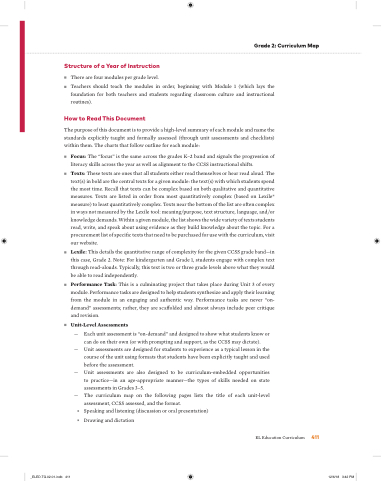Page 437 - EL Grade Teacher Guide - Module 1
P. 437
Grade 2: Curriculum Map
Structure of a Year of In ruction
There are four modules per grade level.
Teachers should teach the modules in order, beginning with Module 1 (which lays the foundation for both teachers and students regarding classroom culture and instructional routines).
How to Read This Document
The purpose of this document is to provide a high-level summary of each module and name the standards explicitly taught and formally assessed (through unit assessments and checklists) within them. The charts that follow outline for each module:
Focus: The “focus” is the same across the grades K–2 band and signals the progression of literacy skills across the year as well as alignment to the CCSS instructional shifts.
Texts: These texts are ones that all students either read themselves or hear read aloud. The text(s) in bold are the central texts for a given module: the text(s) with which students spend the most time. Recall that texts can be complex based on both qualitative and quantitative measures. Texts are listed in order from most quantitatively complex (based on Lexile® measure) to least quantitatively complex. Texts near the bottom of the list are often complex in ways not measured by the Lexile tool: meaning/purpose, text structure, language, and/or knowledge demands. Within a given module, the list shows the wide variety of texts students read, write, and speak about using evidence as they build knowledge about the topic. For a procurement list of speci c texts that need to be purchased for use with the curriculum, visit our website.
Lexile: This details the quantitative range of complexity for the given CCSS grade band—in this case, Grade 2. Note: For kindergarten and Grade 1, students engage with complex text through read-alouds. Typically, this text is two or three grade levels above what they would be able to read independently.
Performance Task: This is a culminating project that takes place during Unit 3 of every module. Performance tasks are designed to help students synthesize and apply their learning from the module in an engaging and authentic way. Performance tasks are never “on- demand” assessments; rather, they are sca olded and almost always include peer critique and revision.
Unit-Level Assessments
— —
— —
n n
Each unit assessment is “on-demand” and designed to show what students know or can do on their own (or with prompting and support, as the CCSS may dictate). Unit assessments are designed for students to experience as a typical lesson in the course of the unit using formats that students have been explicitly taught and used before the assessment.
Unit assessments are also designed to be curriculum-embedded opportunities to practice—in an age-appropriate manner—the types of skills needed on state assessments in Grades 3–5.
The curriculum map on the following pages lists the title of each unit-level assessment, CCSS assessed, and the format.
Speaking and listening (discussion or oral presentation) Drawing and dictation
EL Education Curriculum 411
_ELED.TG.02.01.indb 411
12/6/18 3:42 PM


